
 |
Tea Clipper |
 |
| from TeaAntiques.com | ||
| Edition Forty One |
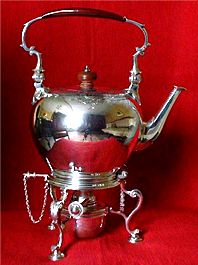
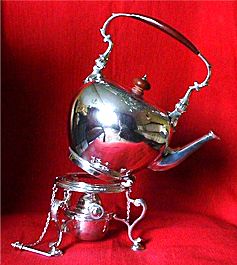 A very desirable and high quality silver 'compressed circular' shaped tea
kettle
in the style of a George I tea kettle c1710. This particular tea kettle dating from 1934
is of heavy gauge silver and beautifully made.
A very desirable and high quality silver 'compressed circular' shaped tea
kettle
in the style of a George I tea kettle c1710. This particular tea kettle dating from 1934
is of heavy gauge silver and beautifully made.
The attractive swing handle of the tea kettle is of silver, with a stitched leather handle covering the top portion allowing it to be handled when the kettle is full of hot water. Either side of the leather covered top of the handle, the handle is formed of delightful scrolls terminating at the swivel joint with a hexagonal shaped flower head.
The tea kettle stands upon a stepped circular foot rim giving it a good solid base. This raised foot rim fits into the burner stand and is secured by two silver pins on chains. The pin at the front passes through a spigot on the front of the kettle, allowing it to be tilted forward when the second pin at the back is removed. Thus a teapot can be filled with ease by just tipping the kettle forward in safety. With both pins securely in place, the tea kettle can be lifted around safely by the swing handle, keeping the kettle secured to the burner stand.
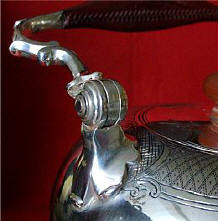
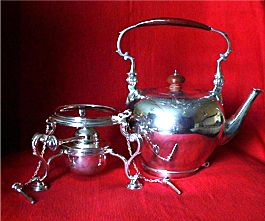
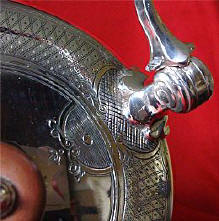
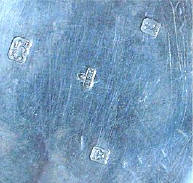 The tea kettle is beautifully and very
clearly hallmarked. There are
also further hallmarks inside the lid of the tea kettle and on the swing
handle. The stand is hallmarked on the upper frame.
The tea kettle is beautifully and very
clearly hallmarked. There are
also further hallmarks inside the lid of the tea kettle and on the swing
handle. The stand is hallmarked on the upper frame.
This is certainly the 'Rolls-Royce' of Tea Kettles and would be a delightful addition to the tea table at tea time. It is a faithful copy of a George I style Tea Kettle, but at a fraction of the price.
Other tea related antiques can be found by visiting my web site at www.TeaAntiques.com.
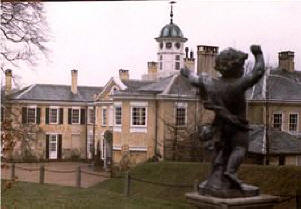 A most charming Edwardian country house, set up on high ground with splendid
views over the Surry Downs. Polesden Lacey was the home of the Greville's until
it was passed over to the care of the National Trust by the Honourable Mrs
Ronald Greville. The house has a history that dates back beyond the Edwardian
period, indeed the house building was begun in 1821 to designs by Thomas Cubitt.
The exterior of the house is much the same as it was when it was built in the
early nineteenth century to Cubitt's design, with a few minor alterations and
additions. An extension to the East elevation, also the adding of the cupola and
remodelling of the entrance portico gave the house the appearance that we see
today. It is styled rather like a Regency 'villa', with a low two storey
construction with bow windows and the stucco walls washed with a sandy yellow
colour.
A most charming Edwardian country house, set up on high ground with splendid
views over the Surry Downs. Polesden Lacey was the home of the Greville's until
it was passed over to the care of the National Trust by the Honourable Mrs
Ronald Greville. The house has a history that dates back beyond the Edwardian
period, indeed the house building was begun in 1821 to designs by Thomas Cubitt.
The exterior of the house is much the same as it was when it was built in the
early nineteenth century to Cubitt's design, with a few minor alterations and
additions. An extension to the East elevation, also the adding of the cupola and
remodelling of the entrance portico gave the house the appearance that we see
today. It is styled rather like a Regency 'villa', with a low two storey
construction with bow windows and the stucco walls washed with a sandy yellow
colour.
There is an open courtyard in the centre of the house that gives it more the appearance of an Italian villa, this courtyard providing light to the corridor that runs round it, this providing access to the rooms which are all positioned on the exterior face of the building.
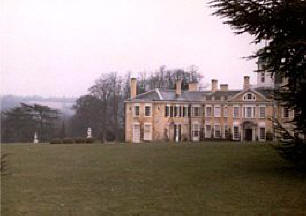
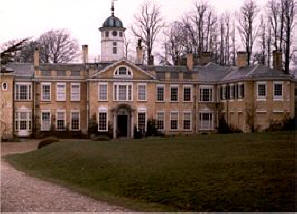
There were houses on this site before this Regency house, but they were demolished. Joseph Bonsor bought the estate and had the present house built. He died in 1835 and the house passed to his son. From then, there have been several owners of the property until it was bought in 1906 by Captain the Honourable Ronald Greville and his wife Margaret. Mrs Greville was responsible for the splendid house interior setting that was to impress her fashionable and famous guests of the time. The perfect Edwardian hostess, she was at the tail end of country house society that was by now dwindling away. As a new age developed when labour was not cheap or available, many household staff sought better employment.
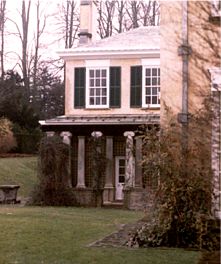 Mrs Greville was a Scottish girl, her father was the founder of the McEwan brewery know as the 'Bass of Scotland'. She was married to the Honourable
Ronald Greville, a Captain in the Life Gaurds, in 1891. In his position near to
the Royal Court, he was a friend of George Keppel who was, with Mrs Alice
Keppel, linked to the King, Edward VII and the 'Marlborough House set'- Alice
Keppel was the King's beloved mistress. With such high links to society, Mrs
Greville cleverly schemed her own social elevation. I get the impression that
she was a formidable hostess, whom you would not wish to cross, as she
could easily be rather vindictive! One essential requirement
for her social elevation was to own a suitable country house in which she could
entertain at these exulted levels and hence the purchase of Polesden Lacey. King
Edward VII was subsequently entertained by Mrs Greville at Polesden Lacey. This
Royal entertaining was to later include other members of our Royal family - her
social standing was secured.
Mrs Greville was a Scottish girl, her father was the founder of the McEwan brewery know as the 'Bass of Scotland'. She was married to the Honourable
Ronald Greville, a Captain in the Life Gaurds, in 1891. In his position near to
the Royal Court, he was a friend of George Keppel who was, with Mrs Alice
Keppel, linked to the King, Edward VII and the 'Marlborough House set'- Alice
Keppel was the King's beloved mistress. With such high links to society, Mrs
Greville cleverly schemed her own social elevation. I get the impression that
she was a formidable hostess, whom you would not wish to cross, as she
could easily be rather vindictive! One essential requirement
for her social elevation was to own a suitable country house in which she could
entertain at these exulted levels and hence the purchase of Polesden Lacey. King
Edward VII was subsequently entertained by Mrs Greville at Polesden Lacey. This
Royal entertaining was to later include other members of our Royal family - her
social standing was secured.
The house interior was remodelled by Mrs Greville using architects Mewes & Davis - the architects who were responsible for the famous London Ritz hotel. Mrs Greville's husband died at the relatively early age of 44, in the wake of his death, Mrs Greville immersed herself even more in being a top society hostess. She was an astute woman, well educated and well versed in politics rather than the arts, she entertained leading politicians at Polesden Lacey. She filled the house with collections of very fine furniture, pictures, porcelain and silver, much of which were supplied by the cream of London's fine arts dealers. With these purchases, she created a cosy looking retreat in the country necessary for her society hosting.
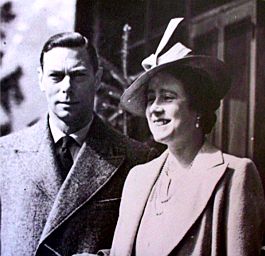 It is at Polesden Lacey that their Royal Highnesses, the Duke and Duchess of
York, later to become King George VI & Queen Elizabeth - the Queen mother, were to
spend part of their honeymoon. What more homely and relaxing place could they
have chosen?
It is at Polesden Lacey that their Royal Highnesses, the Duke and Duchess of
York, later to become King George VI & Queen Elizabeth - the Queen mother, were to
spend part of their honeymoon. What more homely and relaxing place could they
have chosen?
The house is entered through the front door on the East front, leading into a rather dark oak wood panelled Hall hung round with Flemish tapestries. These tapestries are not a set and are of different dates from the late sixteenth century to early eighteenth century.
To the right of the Hall is the Dining Room lined with red silk brocade, which is actually rather an understated room. Not grand, but containing a very long Chippendale style table and chairs, the perfect place for the excellent dinner parties for which she was renowned. There are some fine pieces of early English silver in this room including some seventeenth century tankards and tazzas.
Walking back into the Hall and along the wood panelled Corridor which runs around the open central courtyard, the next room is the Library and Study off at the end. The Library is a light room with South facing windows. Painted a very light colour it has built-in book shelves lined with leather bound books. To one end is a very large library desk and dotted about some comfortable chairs where one could sit and enjoy the wonderful books.
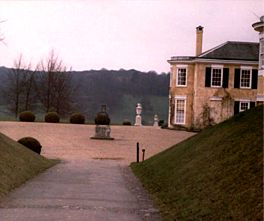
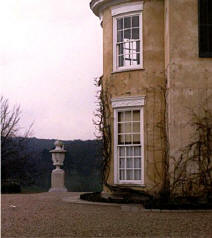 The
small Study at the end of the Library is a lovely room, cosy and light. This
room was a room added to the building by Mrs Greville and has a fine bow window
on the East end and further windows on the South side from where there are
spectacular country views. I was especially delighted to see glazed wall
cabinets packed with some very fine Meissen and Fürstenburg porcelain. I was
particularly taken with a Fürstenburg tea and coffee service that was
beautiful pained with monkeys in human figural forms, so delicately moulded and
exquisitely decorated, c1770. The Meissen also contained some fine tea wares,
these dating from c1730-90.
The
small Study at the end of the Library is a lovely room, cosy and light. This
room was a room added to the building by Mrs Greville and has a fine bow window
on the East end and further windows on the South side from where there are
spectacular country views. I was especially delighted to see glazed wall
cabinets packed with some very fine Meissen and Fürstenburg porcelain. I was
particularly taken with a Fürstenburg tea and coffee service that was
beautiful pained with monkeys in human figural forms, so delicately moulded and
exquisitely decorated, c1770. The Meissen also contained some fine tea wares,
these dating from c1730-90.
An interesting feature in this Study is on the South wall where there is a fireplace directly above which is a window - the chimney stack carefully designed to be taken sideways before upward to the chimney. Further, there are a pair of mirrored shutters that at night could be drawn across this window transforming it to an over-mantle mirror. A very clever design. There is a Carlton House desk in the bow window on which are some family photographs of Mrs Greville her parents and her husband.
The pictures of the house interior that were displayed over the next few paragraphs have been removed at the request of the National Trust.
Moving back into the Corridor and along to the next room, which comes as rather a shock - the ostentatious gilt and mirrored Drawing Room. This room is so out of character with the rest of the house - it is almost unbelievable! Designed to resemble an Italian palatial room, indeed the panelling may have come from an Italian palace. The room has been re-gilded after fire damage in 1961, over 2,000 books of gold leaf were used in its renovation. There is not one surface around the walls and ceiling that is not ornately decorated with white and gilt mouldings and the many wall panel mirrors reflecting this rather gaudy decoration to the nth degree.
On the mantle pieces are some good quality French gilt ormolu clocks. In the Rococo style, they are fitting for this elaborate room.
The Drawing Room contains some delectable French saloon furniture, gilt framed with beautifully embroidered seats and backs. This furniture includes a charming set of gilt framed Louis XV open armchairs with fine tapestries, c1755. Many other pieces of exquisite French furniture are scattered about the room, including some small writing and dressing tables. Large French commodes are positioned up against the walls of the room, these having fine marquetry panels and gilt mounts. This room obviously provided the very rich sumptuous back drop for her party guests who would certainly have been impressed by it. In the evening with the crystal glass chandeliers blazing, the whole room must have become a sparkling paradise.
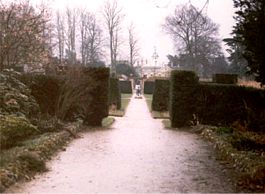 The
next room is probably my favourite room of the house. It is known as the Tea
Room and is situated with windows having very fine views down towards the walled
and formal gardens. What better room is there to enjoy a full Edwardian
afternoon tea with your house guests. The room has delicately carved French
panelling in Louis XVI style, not over the top like the Drawing Room, but of a
much more restrained nature and not gilded! There is French Boudoir type
furniture in the room, including a lovely tapestry covered wood framed settee.
The
next room is probably my favourite room of the house. It is known as the Tea
Room and is situated with windows having very fine views down towards the walled
and formal gardens. What better room is there to enjoy a full Edwardian
afternoon tea with your house guests. The room has delicately carved French
panelling in Louis XVI style, not over the top like the Drawing Room, but of a
much more restrained nature and not gilded! There is French Boudoir type
furniture in the room, including a lovely tapestry covered wood framed settee.
The National Trust has laid the room out beautifully to reflect the afternoon tea of the period. There is a white damask covered table on which is some early English silver that includes a bullet shaped teapot by Gabriel Sleath and a very fine George III silver cake basket filled with fancy cakes. This cake basket is in the shape of a large shell standing on three dolphin feet and with an open scroll handle at one end, this terminated with a cast cherub, London c1750. It is very easy to imagine a lively afternoon tea taking place in true Edwardian style. In fact, in 'Down the kitchen sink' by Beverly Nichols, an afternoon tea is described that actually took place at Polesden Lacey during a weekend party hosted by Mrs Greville:
'Tea is at 5 o'clock... and not at 5 minutes past... which means the Spanish ambassador, who has gone for a walk down the yew avenue, hastily retraces his steps, and the Chancellor of the Exchequer...hurries down the great staircase, and that the various gentleman rise from their chaise-longues... and join the procession to the tea-room. The teapots, cream-jugs, the milk pots and the sugar basins are of Queen Anne silver; the tea service is Meissen; and the doyleys, heavy monogrammed, are of Chantilly lace'
What a wonderful picture this invokes of the importance of the afternoon tea and woe-betide anybody that was late for tea!
Away from the Tea Room there are two further rooms off the Corridor, the Billiards room and Smoking Room, both the domain of the gentleman of these house parties.
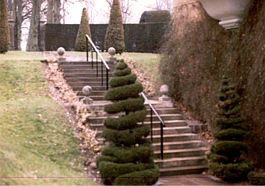
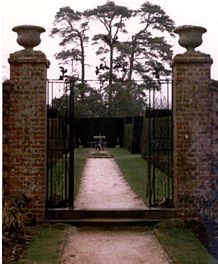
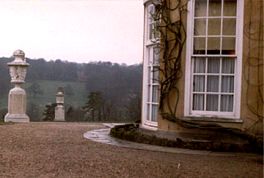
The gardens of the house are a delight to explore, with the stunning views out towards the surrey hills. There are clipped box in the form of spiral pyramids, large walled rose garden and wide herbaceous borders. In addition there is the natural rolling landscape around the house providing this lovely tranquil country house setting. A charming house and garden to be enjoyed by all those fortunate enough to visit.
Polesden LaceyClick here for
Local Map
Map courtesy of www.streetmap.co.uk
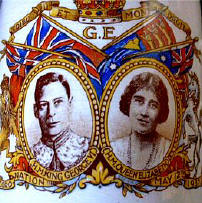 Having spent a delightful day at Polesden Lacey, I wondered what the Queen
Mother may have enjoyed for afternoon tea at this house. She was there on her
honeymoon with her husband, who was later to became George VI. When at Polesden
Lacey, this happy couple were the Duke and Duchess of York, unaware that they
were destined to become King and Queen of England. Following the abdication in
1936 of his brother Edward VIII, after his intention of marrying the American
divorcee Mrs Wallis Simpson, the Duke and Duchess of York were suddenly elevated
to King George VI and Queen Elizabeth.
Having spent a delightful day at Polesden Lacey, I wondered what the Queen
Mother may have enjoyed for afternoon tea at this house. She was there on her
honeymoon with her husband, who was later to became George VI. When at Polesden
Lacey, this happy couple were the Duke and Duchess of York, unaware that they
were destined to become King and Queen of England. Following the abdication in
1936 of his brother Edward VIII, after his intention of marrying the American
divorcee Mrs Wallis Simpson, the Duke and Duchess of York were suddenly elevated
to King George VI and Queen Elizabeth.
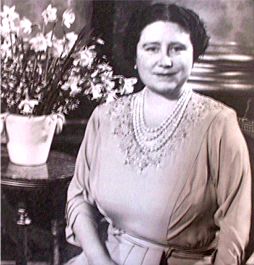 Back
home, I tried to create what the Queen Mother may have enjoyed for afternoon tea
at Polesden Lacey. She was a great lover of gardens and would have relished
taking tea out in the garden there on a sunny afternoon. Tea in the 1930's would
probably involved the quintessentially English cucumber sandwiches and a light
cream filled sponge cake, such as coffee and walnut, which I believe was a
strong favourite of the Queen Mother.
Back
home, I tried to create what the Queen Mother may have enjoyed for afternoon tea
at Polesden Lacey. She was a great lover of gardens and would have relished
taking tea out in the garden there on a sunny afternoon. Tea in the 1930's would
probably involved the quintessentially English cucumber sandwiches and a light
cream filled sponge cake, such as coffee and walnut, which I believe was a
strong favourite of the Queen Mother.
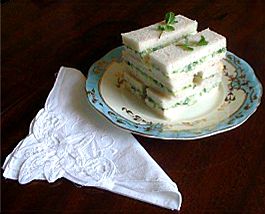
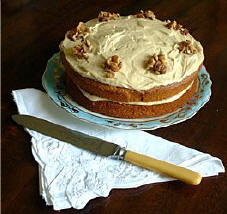
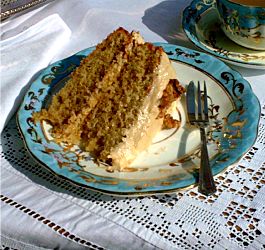 Therefore,
for
my tea, I baked a coffee and walnut sponge to a recipe from a book by Marguerite
Patten, war time food advisor of this period. The light and fluffy sponge cake
is flavoured with coffee essence and sandwiched with a rich butter cream filling
which is also flavoured with coffee essence. Topped with walnuts, the result is
a perfect afternoon tea cake with a very good flavour.
Therefore,
for
my tea, I baked a coffee and walnut sponge to a recipe from a book by Marguerite
Patten, war time food advisor of this period. The light and fluffy sponge cake
is flavoured with coffee essence and sandwiched with a rich butter cream filling
which is also flavoured with coffee essence. Topped with walnuts, the result is
a perfect afternoon tea cake with a very good flavour.
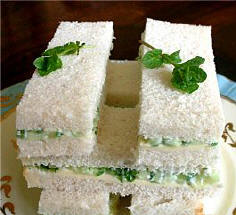 Cucumber
sandwiches served in society or in Royal circles have a few simple ingredients
and special method of construction. Firstly, the cucumber is grated rather than sliced
and is then drained in a colander with a pinch of salt added to help drawer out
the excess moisture. After approximately 15 minutes, mix the grated cucumber
with a teaspoon or so of mayonnaise and add some finely chopped fresh garden
mint. This mixture really does lift and enhance the fresh flavour of the
cucumber. Use good quality white bread, sliced as thinly as possible. Butter the
bread using a good salty butter and fill with the cucumber mixture. Cucumber
sandwiches should always be served in style, with the bread crusts cut off and
the sandwiches cut into nice thin fingers.
Cucumber
sandwiches served in society or in Royal circles have a few simple ingredients
and special method of construction. Firstly, the cucumber is grated rather than sliced
and is then drained in a colander with a pinch of salt added to help drawer out
the excess moisture. After approximately 15 minutes, mix the grated cucumber
with a teaspoon or so of mayonnaise and add some finely chopped fresh garden
mint. This mixture really does lift and enhance the fresh flavour of the
cucumber. Use good quality white bread, sliced as thinly as possible. Butter the
bread using a good salty butter and fill with the cucumber mixture. Cucumber
sandwiches should always be served in style, with the bread crusts cut off and
the sandwiches cut into nice thin fingers.
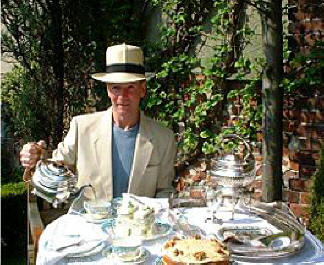
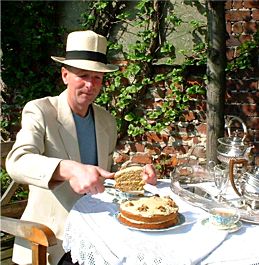
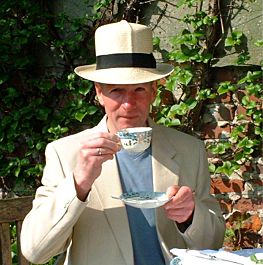
What could be better than to enjoy these delicate cucumber sandwiches sat in the garden in warm spring sunshine. Knowing the Queen Mother's love of pale blue and turquoise, I chose to use a Victorian tea service that has a pale blue border with violet flowers and brightly gilded decoration - this I refer to as my own Queen Mother teaset. A table set with this on a white damask table cloth together with a few items of tea silver, including a tea kettle I think make the perfect recreation. A tea kettle like the one featured as my antique of the month, would have been the best quality type used and enjoyed in the 1930's.
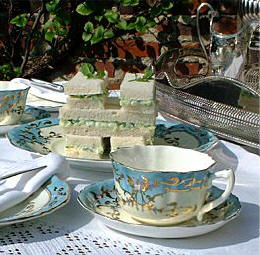
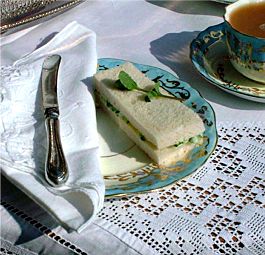
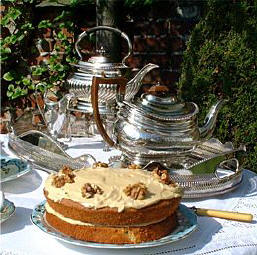
I am sure that the late Queen Mother would have enjoyed this afternoon tea, had she been here - God bless her and long live this type of afternoon tea.
To review past newsletters, just follow this link:
Past newsletters.
To subscribe to this free newsletter -
Click here